| Features | ➢ Multi-function welding – MIG/MAG, MMA, and SOLID CORED Wire welding. |
|---|
₹38,500.00 ₹31,000.00
MIG welding , is an abbreviation for “Metal Inert Gas” which is more
formally known as “Gas Metal Arc Welding” or “GMAW”. The term MIG comes from
the original shielding gasses used that were the inert, or Nobel, gasses. Today
the gases used vary, so the name has officially been changed to “Gas Metal Arc
Welding”. MIG welding is the slang term that is commonly accepted. It is also
known as “Wire Wheel Welding”. This process uses a wire feed to feed solid
filler wire to the weld joint.
MIG welding is an excellent choice for all types of metals, and with the
benefits of a single pass there is little need for any additional shielding
gas. As the weld shrinks, the gasses escape from the joint, leaving it fully
protected from oxidation and moisture. Using just one gas instead of both argon
and helium also saves you money in gas costs and limits the risk of leaks when
transporting or storing your equipment as there are no other gases needed to
store compared to arc welders and they reduce corrosion with no other gases
required.
| Model | UNIT | JMG-300E |
| Rated input voltage | V | AC 380±10% |
| Phase | Three | |
| Frequency | Hz | 50/60 |
| Rated Input Power | KVA | 13.9 |
| Range of welding current regulation | A | 40-300 |
| Operating voltage | V | DC 16-32V |
| Wire diameter | mm | 0.8/1.0 |
| Drive roll | mm | 0.8/1.0 |
| Output valtage | V | 28 |
| Duty cycle | % | 60 |
| Efficiency | % | 85 |
| Degree of Protection | class | IP21S. |
| Feeder | Type | Seprate |
| Wire Feed Speed | m/min | 2.5-24 |
| Insulation grade | F | |
| System of cooling | Type | Fan |
| Dimension (L*B*H) | mm | 480*350*410 |
| Weight | Kg | 27.5 |
Portability: Portable welders are great for jobs that require you to move around. These are typically smaller and lighter than their industrial counterparts.
Power source: Look for a machine that runs on a voltage compatible with your workshop or home power supply. Many machines run on 110V or 220V power.
Duty cycle: The duty cycle is the amount of time a welder can operate continuously at a given amperage before it needs to cool down.
For home and hobby use, a lower duty cycle is acceptable, while professional welders need a higher duty cycle for extended use.
High speed and productivity
Related products
-
Sale!
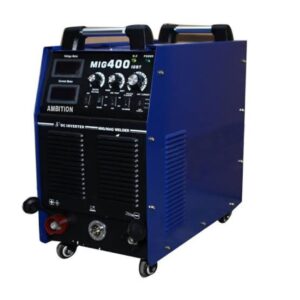 Add to Quote
Add to QuoteMIG welding , is an abbreviation for “Metal Inert Gas” which is more
formally known as “Gas Metal Arc Welding” or “GMAW”. The term MIG comes from
the original shielding gasses used that were the inert, or Nobel, gasses. Today
the gases used vary, so the name has officially been changed to “Gas Metal Arc
Welding”. MIG welding is the slang term that is commonly accepted. It is also
known as “Wire Wheel Welding”. This process uses a wire feed to feed solid
filler wire to the weld joint.MIG welding is an excellent choice for all types of metals, and with the
benefits of a single pass there is little need for any additional shielding
gas. As the weld shrinks, the gasses escape from the joint, leaving it fully
protected from oxidation and moisture. Using just one gas instead of both argon
and helium also saves you money in gas costs and limits the risk of leaks when
transporting or storing your equipment as there are no other gases needed to
store compared to arc welders and they reduce corrosion with no other gases
required. -
Sale!
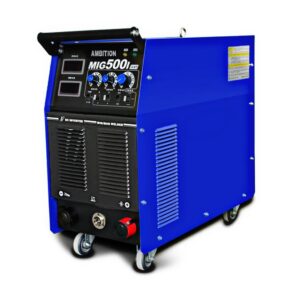 Add to Quote
Add to QuoteMIG welding , is an abbreviation for “Metal Inert Gas” which is more
formally known as “Gas Metal Arc Welding” or “GMAW”. The term MIG comes from
the original shielding gasses used that were the inert, or Nobel, gasses. Today
the gases used vary, so the name has officially been changed to “Gas Metal Arc
Welding”. MIG welding is the slang term that is commonly accepted. It is also
known as “Wire Wheel Welding”. This process uses a wire feed to feed solid
filler wire to the weld joint.MIG welding is an excellent choice for all types of metals, and with the
benefits of a single pass there is little need for any additional shielding
gas. As the weld shrinks, the gasses escape from the joint, leaving it fully
protected from oxidation and moisture. Using just one gas instead of both argon
and helium also saves you money in gas costs and limits the risk of leaks when
transporting or storing your equipment as there are no other gases needed to
store compared to arc welders and they reduce corrosion with no other gases
required. -
Sale!
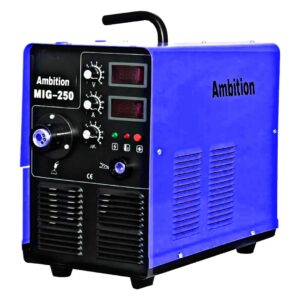 Add to Quote
Add to QuoteMIG welding , is an abbreviation for “Metal Inert Gas” which is more
formally known as “Gas Metal Arc Welding” or “GMAW”. The term MIG comes from
the original shielding gasses used that were the inert, or Nobel, gasses. Today
the gases used vary, so the name has officially been changed to “Gas Metal Arc
Welding”. MIG welding is the slang term that is commonly accepted. It is also
known as “Wire Wheel Welding”. This process uses a wire feed to feed solid
filler wire to the weld joint.MIG welding is an excellent choice for all types of metals, and with the
benefits of a single pass there is little need for any additional shielding
gas. As the weld shrinks, the gasses escape from the joint, leaving it fully
protected from oxidation and moisture. Using just one gas instead of both argon
and helium also saves you money in gas costs and limits the risk of leaks when
transporting or storing your equipment as there are no other gases needed to
store compared to arc welders and they reduce corrosion with no other gases
required. -
Sale!
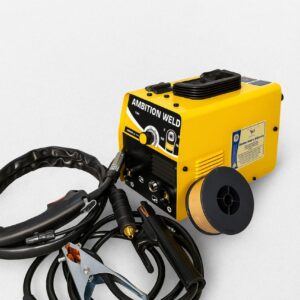 Add to Quote
Add to QuotePortability: Without the need for bulky gas cylinders, the welder is more mobile and convenient for working in different locations.
Outdoor welding: The flux provides its own shielding, which is not easily dispersed by wind. This makes it ideal for outdoor and windy conditions where traditional gas shielding would be ineffective.
Effective on thicker materials: Gasless welding tends to run hotter and offers better penetration, making it well-suited for welding thicker metals and structural steel.
Welds dirty and rusty metal: The flux can burn through some surface impurities, so less prep work is needed compared to gas-shielded welding.
Lower cost: The initial setup cost is cheaper since you don’t need to buy or lease gas cylinders and regulators. -
Sale!
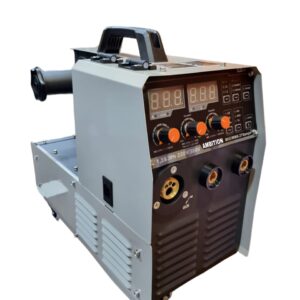 Add to Quote
Add to QuoteMIG welding , is an abbreviation for “Metal Inert Gas” which is more
formally known as “Gas Metal Arc Welding” or “GMAW”. The term MIG comes from
the original shielding gasses used that were the inert, or Nobel, gasses. Today
the gases used vary, so the name has officially been changed to “Gas Metal Arc
Welding”. MIG welding is the slang term that is commonly accepted. It is also
known as “Wire Wheel Welding”. This process uses a wire feed to feed solid
filler wire to the weld joint.MIG welding is an excellent choice for all types of metals, and with the
benefits of a single pass there is little need for any additional shielding
gas. As the weld shrinks, the gasses escape from the joint, leaving it fully
protected from oxidation and moisture. Using just one gas instead of both argon
and helium also saves you money in gas costs and limits the risk of leaks when
transporting or storing your equipment as there are no other gases needed to
store compared to arc welders and they reduce corrosion with no other gases
required.


